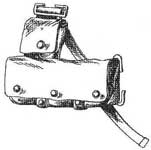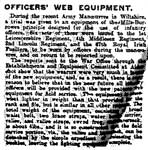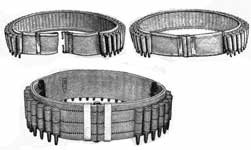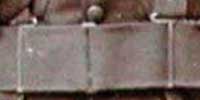Web Equipment, Officers, Model of 1910
Introduction
 With their Mills-Burrowes Equipment accepted into service by the British Army, as Pattern 1908 Web Infantry Equipment, the Mills Equipment Company set about maximising the potential of their design. They could not have foreseen the business success that lay round the corner, in 1914, or they might have rested on their laurels in 1909. What would characterise Mills was their drive to develop new designs, improve components and weaving techniques and to conduct a marketing drive across the World.
With their Mills-Burrowes Equipment accepted into service by the British Army, as Pattern 1908 Web Infantry Equipment, the Mills Equipment Company set about maximising the potential of their design. They could not have foreseen the business success that lay round the corner, in 1914, or they might have rested on their laurels in 1909. What would characterise Mills was their drive to develop new designs, improve components and weaving techniques and to conduct a marketing drive across the World.
 Their next complete equipment design drew heavily on the basic Pattern 1908 design. They had already unsuccessfully offered their Wise-Twigg Equipment (right), as a webbing substitute for Patt. ’03 Bandolier Equipment. They were now looking for a share of the market then dominated by the Sam Browne Belt, though they were careful not to refer to it in the Patent 7797 of 1910, for which the Application Date was 31st March. Bracketed under the date was a line stating “…Patent of Addition to No. 28,812 18th Dec., 1908…”, thereby firmly confirming its origins in Patt. 1908 W.E. The new web design addressed the needs of “…officers and other persons who may wish to vary at will the number and disposition of the carriers or pockets on the equipment…”. When first encountered, in 1987, it was pigeon-holed as a paper design and no more, since no use had ever been noted in any document.
Their next complete equipment design drew heavily on the basic Pattern 1908 design. They had already unsuccessfully offered their Wise-Twigg Equipment (right), as a webbing substitute for Patt. ’03 Bandolier Equipment. They were now looking for a share of the market then dominated by the Sam Browne Belt, though they were careful not to refer to it in the Patent 7797 of 1910, for which the Application Date was 31st March. Bracketed under the date was a line stating “…Patent of Addition to No. 28,812 18th Dec., 1908…”, thereby firmly confirming its origins in Patt. 1908 W.E. The new web design addressed the needs of “…officers and other persons who may wish to vary at will the number and disposition of the carriers or pockets on the equipment…”. When first encountered, in 1987, it was pigeon-holed as a paper design and no more, since no use had ever been noted in any document.
 Past experience has taught that Mills' Patents should not be completely ignored, however unlikely the drawings might seem. Patent 28,812 / 1906, for what became Patt. '08 W.E., showed continuous flaps over the pockets of the Cartridge carriers (see detail at left). Given what the Carriers actually looked like, this was dismissed as implausible - until a small photograph was discovered (below right). It was incorrectly captioned as Miller-Burne Equipment, which should have read Mills-Burrowes, but it clearly showed continuous flaps. The question then arises – was such a design actually manufactured? A chance discovery was that a design was certainly made-up and trialled.
Past experience has taught that Mills' Patents should not be completely ignored, however unlikely the drawings might seem. Patent 28,812 / 1906, for what became Patt. '08 W.E., showed continuous flaps over the pockets of the Cartridge carriers (see detail at left). Given what the Carriers actually looked like, this was dismissed as implausible - until a small photograph was discovered (below right). It was incorrectly captioned as Miller-Burne Equipment, which should have read Mills-Burrowes, but it clearly showed continuous flaps. The question then arises – was such a design actually manufactured? A chance discovery was that a design was certainly made-up and trialled.
 I had obtained some back numbers of the National Army Museum’s Yearbook, simply to complete a series on Army Binoculars, which had commenced in 1981. In Army Museum '84, P. 37 of Part 4 of this series, by an un-credited author, proved interesting, firstly for an incorrectly captioned group photo. This was of officers on the North-West Frontier in 1930, allegedly wearing “…an early version of the Pattern 1937 for officers…” It actually showed Web Equipment for Officers, of the post 1919 design (to be covered in better detail in a future upgrade to this section of KW). The photograph was illustrating a section dealing with the carriage of binoculars, wherein lay a surprise discovery on Page 37. Reference was made to Mills loaning sets of “…Mills Burrowes webbing equipment for officers…”. Significantly, this was in 1910 and, given the above, it is entirely likely that the officer sets used were exactly as those shown in Patent 7797 / 1910. It would have required little effort on Mills' part to have made up sets, sufficient for the officers involved.
I had obtained some back numbers of the National Army Museum’s Yearbook, simply to complete a series on Army Binoculars, which had commenced in 1981. In Army Museum '84, P. 37 of Part 4 of this series, by an un-credited author, proved interesting, firstly for an incorrectly captioned group photo. This was of officers on the North-West Frontier in 1930, allegedly wearing “…an early version of the Pattern 1937 for officers…” It actually showed Web Equipment for Officers, of the post 1919 design (to be covered in better detail in a future upgrade to this section of KW). The photograph was illustrating a section dealing with the carriage of binoculars, wherein lay a surprise discovery on Page 37. Reference was made to Mills loaning sets of “…Mills Burrowes webbing equipment for officers…”. Significantly, this was in 1910 and, given the above, it is entirely likely that the officer sets used were exactly as those shown in Patent 7797 / 1910. It would have required little effort on Mills' part to have made up sets, sufficient for the officers involved.
 The sets were used by several regiments in what the author incorrectly stated was an unofficial Troop Trial, during manoeuvres in September 1910. The footnote quoted an item in the Leicester Mercury newspaper. A copy of the relevant page was obtained, through the good auspices of Miss Lynda Smart, the paper’s Chief Librarian. Under a long column, Military Notes, by “Pom-Pom”, was a sub-item Officers' Web Equipment. This referred to recent Army Manoeuvres in Wiltshire, Mills having loaned just six sets of “…equipment of the Mills-Burrowes principle…” to the 1st Leicestershire, 4th Middlesex, 2nd Lincolnshire Regiments and the 87th Royal Irish Fusiliers. Six into four does not compute very fairly and it may be that Pom-Pom meant six sets to each of the four regiments? The photo at left will take you to a transcript of the article. See the List of Changes page for an actual PDF file of the newspaper page.
The sets were used by several regiments in what the author incorrectly stated was an unofficial Troop Trial, during manoeuvres in September 1910. The footnote quoted an item in the Leicester Mercury newspaper. A copy of the relevant page was obtained, through the good auspices of Miss Lynda Smart, the paper’s Chief Librarian. Under a long column, Military Notes, by “Pom-Pom”, was a sub-item Officers' Web Equipment. This referred to recent Army Manoeuvres in Wiltshire, Mills having loaned just six sets of “…equipment of the Mills-Burrowes principle…” to the 1st Leicestershire, 4th Middlesex, 2nd Lincolnshire Regiments and the 87th Royal Irish Fusiliers. Six into four does not compute very fairly and it may be that Pom-Pom meant six sets to each of the four regiments? The photo at left will take you to a transcript of the article. See the List of Changes page for an actual PDF file of the newspaper page.
Reports were sent through the Establishments and Equipment Committee, to the War Office. This makes it very much an official trial. Pom-Pom reported that “…the wearers were very much in favour…there is every reason to believe that in the near future all infantry officers will be provided with the new pattern web equipment for field service…”. Although an observer from the manufacturer might ordinarily be present, at so important a trial, this probably was not necessary here. It seems only right to point out the presence of a very partial observer – in the Army. The Adjutant of the 87th R.I.F. was one Major Arnold R. Burrowes, better known as the co-developer of Mills-Burrowes Equipment. He was certainly receiving royalties for the life of Patent 28,812 / 1906 and this officer set was a derivation of that.
As the sets were items on loan, they were returned to Mills, who most probably would have "...reduced to produce...", as the Army cliche has it. Despite the favourable reports, nothing resulted, or did it? The Wheels of Military Progress grind slowly. LoC 16513 was approved in 1913, adding a revised design of Attachments, brace, the Belt, waist, special and leather Case, pistol, Webley, with brass hooks and Pouch, ammunition, Webley, with brass hooks. Might these have resulted from the 1910 trials - not so much an officers’ equipment, but as a sop to pistol users? In any event, Mills must at least have derived some research data and were plainly un-daunted by their failure to secure an order. In the following years, the potential of their designs changed dramatically. In 1911 alone, Patents were taken out on reduction weaving for Braces, a revised Mills-Burrowes Belt, now with 1-inch buckles on the inside face, a revised and a more recognisable Brace attachment and a “Back-adjustment” belt of narrower width. Also in this year, two full infantry designs were patented, the second of which would form the basis for the Patt. ’13 W.E. bought by Canada. The 1910 idea of envelopes linked to those for binoculars and pistol, was taken a step further in 1916. A recognisable cavalry set was now patented as a “back adjustment” design, so the Pistol case / Ammunition pouch and Binocular case / Compass pocket were illustrated as a Side piece assemblies, as the 1910 design had proposed and as was used in Patt. ’40 Cavalry W.E.
Mills did succeed in supplying webbing equipment for officers, but it took the Great War to create the conditions for this. Though it was never “issue”, as was hoped-for in 1910, it was Private Purchase and, post 1918, would appear in Regimental Orders as regulation wear within units. In its details, materials and fittings, the 1910 model differed considerably from the design that appeared in 1916, which borrowed heavily from their 1916 cavalry design. However, the principles had first been established in the 1910 design, right down to the innovative coupling of the Holster to Ammunition pouch and the Binocular case to another small Pouch. Even the support system for a Pack or Haversack was clearly defined.
There is an interesting aside to the 1910 Manoeuvres: Major Winston Spencer Churchill, M.P. was in attendance, as C.O. of the Henley Squadron, Queen’s Own Oxfordshire Yeomanry (T.F.). He was also the Home Secretary. Picture any of today’s lot doubling-up this way! In 1895, on leave from the 4th Queen’s Royal Irish Hussars, he chose to observe the Cuban Insurrection. Staging through the U.S.A., Churchill had visited various military establishments, including West Point. It is very likely he saw Mills Web Cartridge Belts in use. In 1897, he wrote his first book, The Story of the Malakand Field Force. On P.200-201, as part of a chapter Military Observations, he comments how much better it would be to dispense with the existing heavy leather accoutrements (Valise Equipment, Pattern 1888). He adds that it would be better to have accoutrements “…made of web…”. Churchill was always interested in technical advances (tanks, Mulberry Harbour, etc), so he must have been aware of the infantry’s new Patt. ’08 W.E., even though he was a Yeomanry officer. During the 1910 Manoeuvres he was wearing a Sam Browne Belt. Perhaps he saw the experimental web officers’ accoutrements and was envious?
 Responding to my request, the diligence of Robin Jenkins, Keeper (Collections), at the Leicestershire, Leicester & Rutland Record Office, has uncovered two significant items of documentation. Received on 4 August, the Lincolnshire Regiment's gazette, The Green Tiger, Vol. 9, P. 134 (September 1910) contained the following statement: "...The new pattern officers' web equipment is being tried by six officers of the battalion during manoeuvres...". With the Leicester Daily Mercury record, this doubled the contemporary documentation, in one fell swoop!
Responding to my request, the diligence of Robin Jenkins, Keeper (Collections), at the Leicestershire, Leicester & Rutland Record Office, has uncovered two significant items of documentation. Received on 4 August, the Lincolnshire Regiment's gazette, The Green Tiger, Vol. 9, P. 134 (September 1910) contained the following statement: "...The new pattern officers' web equipment is being tried by six officers of the battalion during manoeuvres...". With the Leicester Daily Mercury record, this doubled the contemporary documentation, in one fell swoop!
It confirmed my doubt that Mills had loaned only six sets, to be divided up between four regiments, pointing instead to 24 sets having been manufactured. Later that day, Robin topped even this, with a photograph of F Company at the Manoeuvres (left). In front of his men, a Lieutenant is wearing something that cannot be a Sam Browne Belt. As this was the day of upload, we were unable to include it, but Robin has very kindly agreed to Karkee Web reproducing this unique (thus far) piece of evidence - its first outing in a century. Discoveries like these happen very rarely and almost never in a timely manner. You saw it first in Karkee Web!! For a reproduction of the entire page from The Green Tiger, go to the W.E.O. Model of 1910 List of Changes & Official Documentation page.
 For the moment, the Component text has been left un-changed, but the photograph reveals some changes from the precise forms shown in the Patent drawing. The Binocular case is here a separate item, which makes complete sense. Mills would have provided the means of permutating the assemblies, consistent with the wording of the Patent. The Sam Browne Scabbard is of original form, having a metal chape and shoe / drag. It is very plain that it is being carried in a Frog deriving from a Bayonet frog. Braces are just discernable, but not the means of their connection to the Belt. The glint of metal fittings is just visible on the edge of the Belt, which may be the hooks shown in the Patent. However, the area above the Belt does not look as "busy" as the Patent form would suggest.
For the moment, the Component text has been left un-changed, but the photograph reveals some changes from the precise forms shown in the Patent drawing. The Binocular case is here a separate item, which makes complete sense. Mills would have provided the means of permutating the assemblies, consistent with the wording of the Patent. The Sam Browne Scabbard is of original form, having a metal chape and shoe / drag. It is very plain that it is being carried in a Frog deriving from a Bayonet frog. Braces are just discernable, but not the means of their connection to the Belt. The glint of metal fittings is just visible on the edge of the Belt, which may be the hooks shown in the Patent. However, the area above the Belt does not look as "busy" as the Patent form would suggest.
 In 1906, the Mills Woven Cartridge Belt Company showed attachment fittings (see photo at left) very like later gate-slides. The Brace is only 1.5-inches wide and Mills may have thought 2-inch strapping too inelegant for the officers' prototypes, electing for hooks instead. It may even be that both forms were used in the trials, since the Brace attachments introduced in 1913, for use with Patt. '08 W.E., used a similar gateslide. The belt buckle is also difficult to resolve, but it may not be a Twigg Buckle, nor the "loop and olivet" used on U.S. M-1910 Cartridge Belts and the Cavalry Belts of 1912 and 1913. The lack of detail does suggest that a reversion has occurred, to the "C" hook, with slides, as in the Model 130 Mills Double Loop Belt above right. Although outmoded by Mills technical advances, it is an "elegant solution", ideal for an officers accoutrements. The asymmetric result of fastening a Twigg Buckle - by the book - whilst efficient, is certainly not elegant.
In 1906, the Mills Woven Cartridge Belt Company showed attachment fittings (see photo at left) very like later gate-slides. The Brace is only 1.5-inches wide and Mills may have thought 2-inch strapping too inelegant for the officers' prototypes, electing for hooks instead. It may even be that both forms were used in the trials, since the Brace attachments introduced in 1913, for use with Patt. '08 W.E., used a similar gateslide. The belt buckle is also difficult to resolve, but it may not be a Twigg Buckle, nor the "loop and olivet" used on U.S. M-1910 Cartridge Belts and the Cavalry Belts of 1912 and 1913. The lack of detail does suggest that a reversion has occurred, to the "C" hook, with slides, as in the Model 130 Mills Double Loop Belt above right. Although outmoded by Mills technical advances, it is an "elegant solution", ideal for an officers accoutrements. The asymmetric result of fastening a Twigg Buckle - by the book - whilst efficient, is certainly not elegant.
Rog Dennis, July 2010